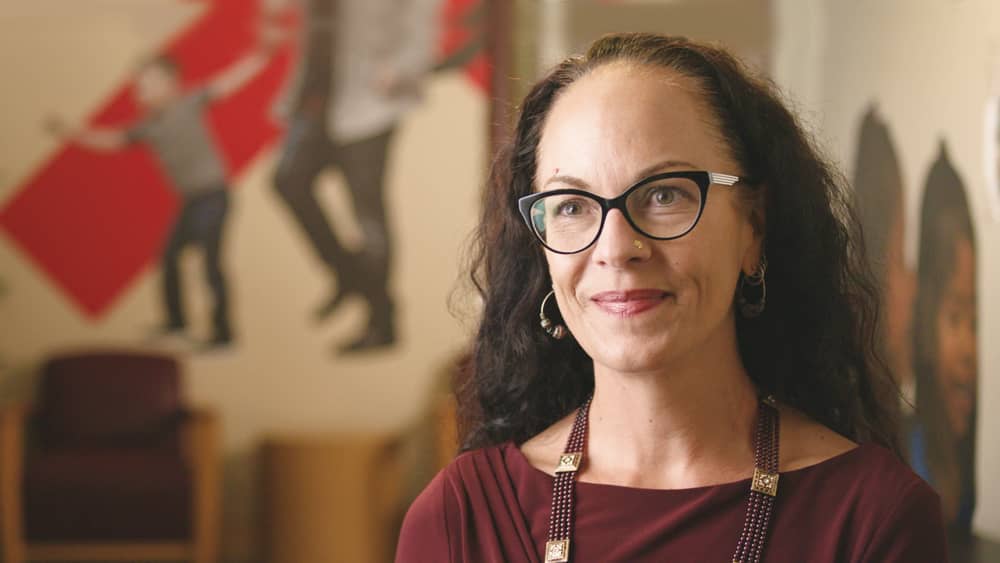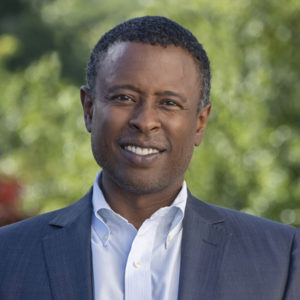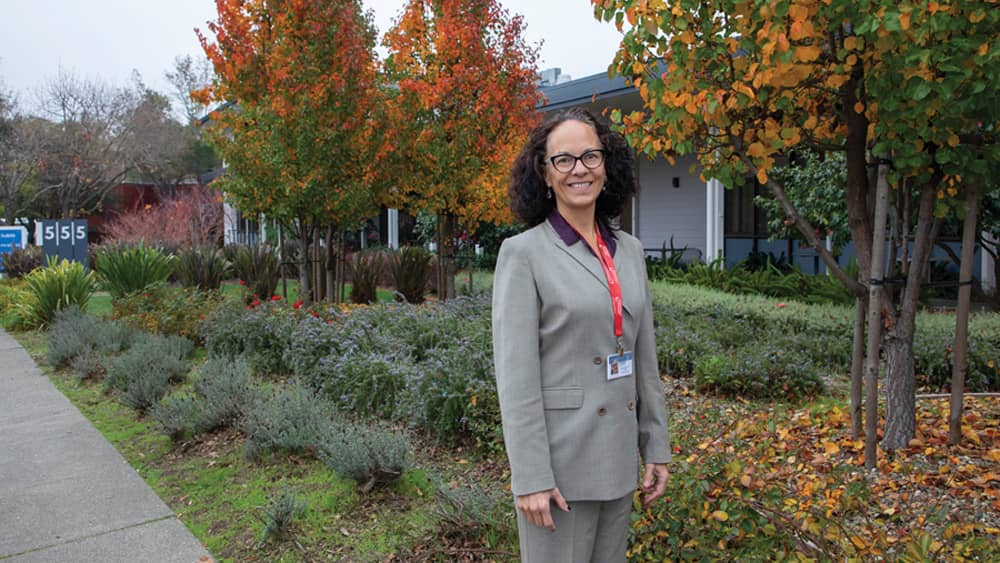
Marin County is well known for its affluence, and yet alongside the wealth, poverty is a constant presence. According to the most recent census figures, 6.9% of the county’s residents live below the poverty line, and for them, trying to get ahead is a perpetual struggle. Marin, though, has a generous spirit, with an estimated 1,800 nonprofit organizations and many of them offer opportunities for disadvantaged people to better their lives. Among them, San Rafael-based Community Action Marin leads the way in reaching out to the less fortunate with a variety of programs.
Chandra Alexandre, CEO of Community Action Marin, points out that it costs roughly $126,000 a year for a family of four to live in Marin County, and residents who fall below that threshold need help if they are to support themselves. “We serve people who generally live far below what it costs for a family to afford basic expenses in Marin County,” she says. Food, access to child care and assistance with paying utilities are common needs. CAM’s mission is to alleviate the causes and consequences of poverty, and when people get help in overcoming the obstacles they face, they have a chance to take advantage of economic opportunities. It’s a win-win situation that allows them to become self-supporting and—in the best outcome—to thrive in the communities where they live.
CAM’s roots go back to 1966, two years after President Lyndon B. Johnson’s war on poverty led to the passage of the Economy Opportunity Act of 1964 and the beginning of the Community Action movement, which sought to eliminate poverty in the midst of plenty. The goal was to provide services to help low-income Americans become self-sufficient, and community action agencies across the country began to provide services that would help vulnerable individuals and families move out of poverty.
CAM started with a federal grant of $40,000, and in 1967, the Marin County board of supervisors made it the county’s official antipoverty agency. Gail Theller was the agency’s first executive director. “She was a real force in getting CAM up and running,” says Roger Crawford, president of the board of directors. Under the guidance of Theller, a Marin Women’s Hall of Fame honoree, CAM grew from a fledgling organization into a dependable provider of support services for the needy. Through collaboration, it was instrumental in the creation of several other agencies, including the Food Bank (now the San Francisco-Marin Food Bank), Homeward Bound of Marin, the Marin Childcare Council and the Agricultural Institute of Marin, which runs the farmers markets at the Marin Civic Center in San Rafael.
Meeting needs
CAM offers a wide range of services to 20,000 individuals annually and adapts to assist with other unique issues as the need arises. During the COVID pandemic, for example, CAM was at the forefront of assisting those on the frontlines who needed child care. “And we continue to stay nimble in response to what people need,” says Alexandre.
More recently, the COVID-19 pandemic created new demands, and it also forced the agency to begin operating remotely and put protocols into place for staff health and well-being. Support groups moved online, and CAM intensified its focus on food justice, as many low-wage workers lost their jobs and income, putting their families at risk of going hungry. Food, child care and assistance with utilities are at the heart of everything the agency does. “Those things don’t change,” Alexandre explains, adding that while CAM does what is necessary to meet new demands, it has always been committed to maintaining its core work.
The cost of living in Marin County has increased by over 50% in the past five years, and the combination of rising costs and a devastating pandemic makes the needs greater than ever. Alexandre reports that the perception of people in need is often that they just need to work harder or make different choices. When they have roadblocks, however, their choices are limited and historic inequities compound the difficulties. The lack of child care, for instance, might limit a parent’s ability to work, and so to combat that problem, CAM provides free and affordable child care for anyone who needs it. “We’re the Head Start grantee in Marin County,” she says, “and we layer funding from both federal and state sources to ensure we meet the highest standards possible to help as many families as possible.” Head Start is a national program for children that begins with prenatal care for mothers and spans the years from birth to age 5. Early Head Start serves children up to 2 years old in a program that is all day, all year round and includes comprehensive health, nutrition, education, social services and family development. Preschool for children 3 to 5 years old offers full-day or part-day options with the school year and year-round options. The federal government subsidizes the program so children from income-eligible families can get the education and experiences they need for future success.
As housing becomes more expensive and less accessible, homelessness continues to grow. “We’re very invested in helping to solve the housing challenges we have in the county,” says Alexandre. Homelessness was already a problem, and then when the pandemic took hold, it further illuminated the needs of those renting in the community. “The need for rental assistance skyrocketed,” she says. In a collaboration to address the issue, CAM worked with Legal Aid of Marin, Canal Alliance, Marin County staff and local government (including San Rafael Mayor Kate Colin and Marin County Supervisor Dennis Rodoni) to assist the Latino community, which the pandemic affected disproportionately. The three community-based organizations and the county administrator’s office worked together to effect policy changes and institute rent freezes, and they got moratoriums extended as well. “We have many, many partnerships,” she says. “When your work is social and economic justice, it indeed takes a village.”
CAM also gives support to individuals who struggle with mental health issues, which have worsened as a result of the isolation the pandemic caused. However, there was also a positive effect. “There’s been a veil lifted from the stigma,” says Alexandre, explaining that the pandemic put a spotlight on the fact that we’re social beings, and people have become more accepting of and willing to talk about mental health challenges. “The services we provide are more visible to people,” she says. With the unwarranted shame removed, she adds, CAM can serve more people who are psychologically challenged and also reach a larger number by offering services over the phone.
One of the biggest issues continues to be food. One in five of Marin County’s residents lacks enough food, and one in three seniors is at risk of going hungry, so the need for food is imperative. Crawford finds that looking at food security and food justice is an important way of seeing what low-income people lack. They don’t have the means to shop at grocery stores that sell healthy and nutritious products, and while others who are better off give to food banks to help people who are poor, he suggests looking at the issue more broadly and finding other ways for the needy to get nourishment as well.
CAM has two programs that go beyond acquiring and providing food. In 2011, it acquired a commercial kitchen in Terra Linda, which is known as the Central Kitchen. For the past 10 years, the agency has had its own space to prepare cold breakfasts, hot lunches and snacks for nearly 1,000 children in its programs. “That kitchen supplies meals to all our kids in preschool every day,” says Alexandre. For some children, it’s their only nutritious meal of the day. The kitchen is also a source of income because food entrepreneurs who need a licensed facility rent the space after hours. In addition, CAM has launched an apprenticeship program for families who want to go into the food business and gives them the support they need to be successful, including business training, thus putting them on a path out of poverty. Plans for the future include using the kitchen to develop CAM’s own products for sale.
CAM has rented the Old Gallinas Children’s Center on N. San Pedro Rd. in Santa Venetia from San Rafael City Schools for 30 years to house its early childhood education programs. The site has a learning garden for preschoolers, but a few years ago, CAM staffers recognized that they had the opportunity to grow the agency’s own food as well. They started planning in the summer of 2019, and the agency made an initial investment of $20,000 to buy equipment and plants and coordinate the project. Habitat for Humanity and Canal Alliance helped with construction, and the first plants began producing crops by the end of that year. In spring 2020, when the pandemic forced businesses to close, food insecurity increased significantly, and CAM’s farmers began planting and harvesting in earnest so they could give food away. Since then, the Production Farm has yielded 1,300 pounds of food including apples, cabbage, cucumbers, tomatoes and zucchini. CAM initally worked with Sanzuma, a local organization that manages organic farms and addresses the need for sustainable healthy food systems and nutrition education. The goals of the partnership are to expand the garden in San Rafael and to develop a second site at Hamilton in Novato in partnership with the Novato Unified School District. Crawford believes the farm has a positive influence on the children who attend programs on the site because they can see that it’s possible to grow and harvest food in an urban environment. “When you’re learning about that as a child, it’s not just the fact that you have access to food that’s growing on a farm,” he says. They also discover ways that they can nourish themselves, especially if they have access to property where they can grow their own food.
In addition to helping people with their basic needs, CAM offers ways for them to learn how to manage their money and attain financial security so they can go beyond subsistence living. One-on-one coaching for a minimum of six months offers strategies for creating and sticking to a budget, reducing debt and perhaps saving for college or homeownership. Fledgling entrepreneurs can also get help to start or expand small businesses.
Anyone who needs connections and support can get assistance. “All of our services are accessible to anyone who lives in Marin County,” says Alexandre, adding that CAM takes a whole family approach and doesn’t have an income eligibility requirement for financial coaching or some of its other stabilization services. “We focus on people’s goals and aspirations and work side by side with them to help them achieve them,” she says. “The more we can support cross-agency connections and develop deep relationships with partners and community, the more we help create a community that’s thriving.”
Connections
The opportunity to create social justice outcomes drew Alexandre to CAM. She points out that an awareness of the need for social justice is currently heightened, and she found the idea of being involved in a commitment to come together as a community to empower everyday people appealing. She also believes that achieving racial justice is important.
“In Marin, which is largely affluent, the population is 80% white,” she says, and race affects all the indicators of well-being. Some of the challenges people face are the result of systemic injustice that disproportionately impacts certain demographics. “We employ over 200 people, many of whom represent the people we serve,” she says. “We have a focus on diversity, equity, inclusion and justice. We embed those principles in how we show up and how we work. Those principles are fundamental to how we work as an agency.” She explains that CAM has a goal for each employee and strives to make sure that each individual belongs. “We specifically name inclusion,” she says. Members of the staff talk about racial justice and inequity and sometimes have difficult conversations, but, she says, “We can’t do it in the world unless we do it in our own house.”

Crawford believes that Alexandre is one of CAM’s big strengths. “We have a pretty dynamic executive. I think Chandra has done a lot to make people aware,” he says. He joined the board of directors in 2013, and a member of the parks commission recognized his desire to get involved in the community and recruited him. As a member of the board, he supports Alexandre’s work, and since becoming CEO, he says that the board is able to be “less hands-on,” a testament to Alexandre’s leadership and involvement in operations, as well as making the policy decisions one expects a board to make. Its members approve the annual budget. “All of our programs go through an audit,” he says. The board reviews the findings and approves the audits. They also approve large contracts and make policy decisions, such as those related to Head Start, the federally-funded Low-Income Energy Assistance Program (LIHEAP), which assists with energy costs, and its own Community Alternative Response (CARE), which helps the homeless while working to make connections and build trust.
One-third of the board’s members are from the low-income community, and everyone goes out into the community with Alexandre and participates in fundraising activities, as well as using social media to connect with networks and ask for donations. “We haven’t had a chance recently to do any hands-on fundraising like we’ve done in the past,” Crawford says, although they will probably return to it after the pandemic has passed. Meanwhile, “Be aware of the need in your own backyard,” he advises, asking people to help however they can. “Money isn’t the only way to help an organization,” he says. CAM welcomes volunteers in a variety of roles from helping to tend the gardens at the agency’s schools to contributing specific skills, such as preparing tax returns.
CAM gets 80% of its funding from the federal government, the State of California and Marin County. In addition, “Marin Community Foundation is a great supporter,” says Alexandre, and individual donations also help. “We’re very transparent about what we do, how we do it and the impact we make. How we work is just as important as what we do,” she adds. That philosophy resonates with people. CAM scores 100 out of a possible 100 on Charity Navigator, an organization noted for its objective assessments of nonprofit organizations throughout the country, and a pair of recent awards are a source of pride. Legal Aid of Marin gave CAM a Partner of Justice Award in July 2021, and in 2020, it earned recognition as a California Nonprofit of the Year for its pandemic response.
She is fully aware of the inequities in the community as the income gap grows, and while CAM has not yet eliminated poverty, it has been effective in minimizing its impact and reducing it by giving people ways to improve their lives. For the people at the forefront, it’s gratifying to lend a hand to those who need it most and see them succeed, and when the help allows them to move toward achieving their dreams, it’s even more satisfying.
Marin Food Day
The United Nations brings together 150 countries on World Food Day in October to raise awareness of food insecurity, poverty and hunger. One in five residents and one in three seniors lacks food security in Marin County. In 2015, the Marin Food Policy Council and the Marin County Board of Supervisors designated October 24 as Marin Food Day to create awareness of hunger and malnourishment in the community.

Community Action, which is the largest nonprofit social services provider in the county, collaborated with the San Francisco-Marin Food Bank, the Marin County HEAL (Healthy Eating Active Living) Collaborative, the Agricultural Institute of Marin and the Marin Food Policy Council on Marin Food Day in 2021. However, “Community Action Marin’s efforts in support of good healthy food for all go beyond this one day,” says Community Action CEO Chandra Alexandre. “The agency’s food justice team supports well-being across generations through its programs, including emergency food boxes and fresh, organic meals in our Head Start and high-quality preschools for over 550 children, in addition to community food distribution that includes produce from our Production Farm.”
Community Action Marin
Community Action Marin provides support for Marin County’s low-income residents in a wide variety of ways.
Children and Family Services
Early Head Start
Home visiting
Family child care
Preschool
School-age
Safety Net
Emergency Family needs
CalFresh assistance
LIHEAP energy program
CARE homeless outreach
Mental Health
Peer mental health
Family partnership
Peer education
Economic Opportunity
Financial empowerment
Support to thrive
Workforce development
Food Justice
Central Kitchen
Renting space
Healthy meals
Production farm
Equity Initiatives
CAM equity work
Marin Equity Initiative
Marin Promise Partnership
Census 2020
Strategic partnerships
Pandemic response
camarin.org



